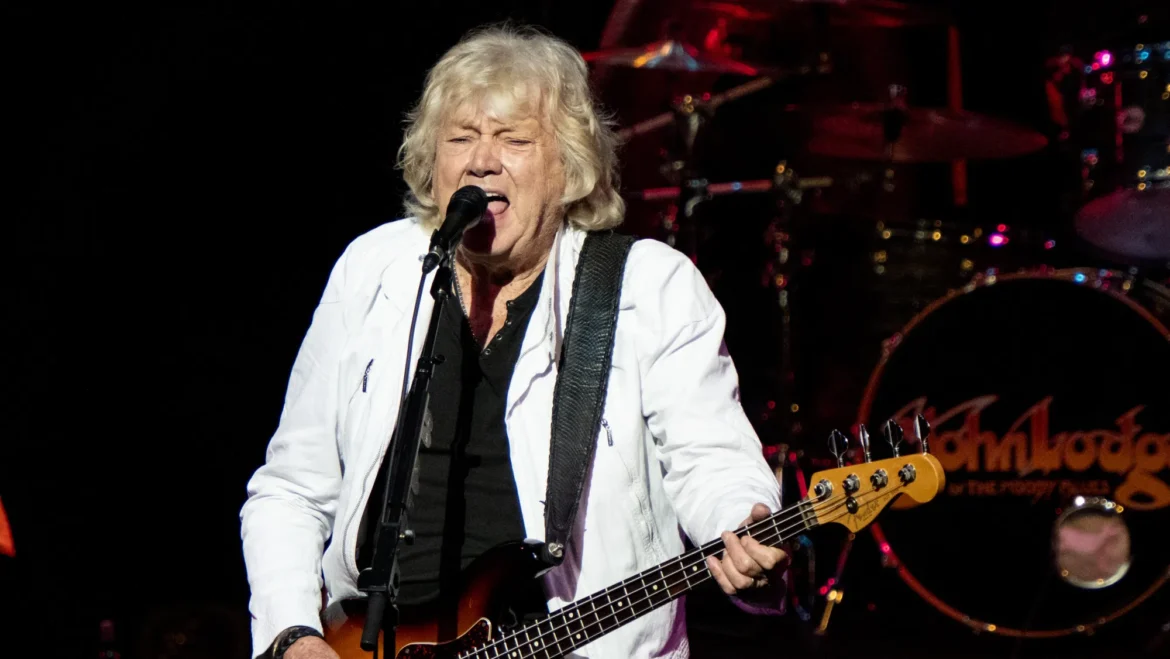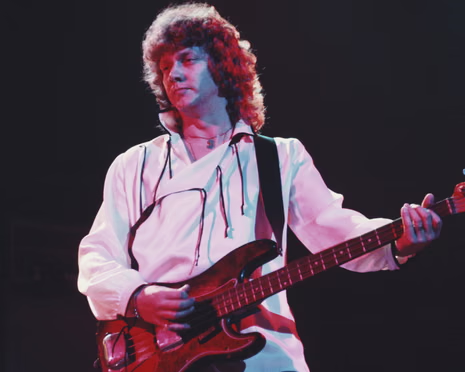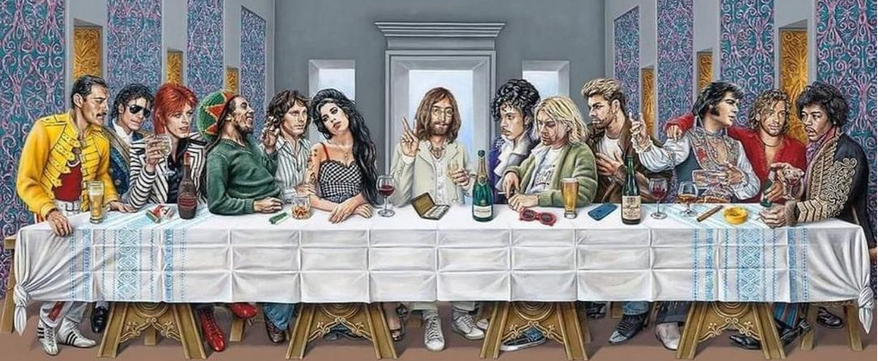
John Lodge (1943–2025): A Life in Music
Early Life and Musical Beginnings
John Lodge was born John Charles Lodge on July 20, 1943 in Birches Green, near Erdington in Birmingham, England. Growing up in a working-class family during the closing years of World War II, he was surrounded by the energy and industriousness of post-war Britain. From an early age, he showed both curiosity and passion for music. The new sounds coming from America—rock and roll, rhythm and blues, and the early stirrings of pop—captured his imagination and would shape his artistic direction.
Lodge attended Birches Green Infant and Junior School, then Central Grammar School, before studying engineering at the Birmingham College of Advanced Technology. Although he was academically capable, his true devotion lay in music. As a teenager, he was influenced by the likes of Buddy Holly, Jerry Lee Lewis, and Chuck Berry—artists whose blend of rhythm, melody, and emotion would guide his musical sensibilities for decades to come.
He bought his first guitar in his early teens and soon after shifted to bass guitar, an instrument that allowed him to combine rhythmic drive with melodic subtlety. Around this time, he began forming early bands with local friends, including future Moody Blues member Ray Thomas. One of these bands, El Riot & the Rebels, performed in and around Birmingham and gave Lodge his first taste of performing in front of enthusiastic crowds.
Joining The Moody Blues
The Moody Blues were formed in 1964 by Denny Laine, Clint Warwick, Mike Pinder, Ray Thomas, and Graeme Edge. Their first big success came with the single “Go Now,” a soulful ballad that reached the top of the charts in Britain and abroad. However, internal changes soon followed, and by 1966 both Laine and Warwick had left the group. The remaining members sought replacements who could not only play but also write songs and contribute vocally.
In 1966, John Lodge joined The Moody Blues, along with Justin Hayward. This lineup—Hayward, Lodge, Pinder, Thomas, and Edge—became the classic Moody Blues configuration that would redefine the band’s sound and propel them to international success. Lodge’s entry marked a creative turning point, shifting the group from its rhythm-and-blues origins toward the more experimental, symphonic, and conceptual direction that would make them one of rock’s most enduring acts.
Musical Contributions and Signature Works
John Lodge quickly established himself as a core creative force within the Moody Blues. His musicianship, songwriting, and vocals were central to the band’s evolution into pioneers of progressive and symphonic rock. Lodge’s bass playing was unusually melodic, weaving counterlines and harmonics that complemented Justin Hayward’s guitar and Mike Pinder’s mellotron textures. His voice, rich and resonant, was equally integral—capable of both lead performances and tight, layered harmonies.
Some of Lodge’s most beloved compositions include:
- “Ride My See-Saw” – A high-energy anthem that captured the optimism and drive of the late 1960s. The song’s propulsive bassline and philosophical lyrics became emblematic of the Moody Blues’ combination of rock vigor and reflective thought.
- “I’m Just a Singer (In a Rock and Roll Band)” – A powerful statement about identity, fame, and purpose, this track was one of the group’s later hits and remains one of their most recognizable songs.
- “Isn’t Life Strange” – A lush, orchestral piece that showcased Lodge’s lyrical sensitivity and the band’s penchant for grandeur.
- “Talking Out of Turn,” “Sitting at the Wheel,” and “Lean on Me (Tonight)” – Songs that demonstrated his consistency as a writer across decades, adapting to the times while retaining his distinct voice.
.
Across the band’s albums—from Days of Future Passed (1967) through In Search of the Lost Chord, A Question of Balance, and Every Good Boy Deserves Favour—Lodge was a pillar of both musical and conceptual development. His songwriting balanced Justin Hayward’s romantic introspection and Mike Pinder’s mysticism with grounded, emotional realism.
John Lodge’s bass playing deserves special note. In an era when the instrument was often confined to the background, he turned it into a vehicle for melody and narrative. His tone was clear and expressive, and his sense of timing precise. It was an approach that influenced many later progressive and classic rock bassists.
Solo Work and Collaborations
While The Moody Blues remained his lifelong artistic home, John Lodge also found fulfillment in solo and collaborative projects.
In 1975, during a temporary hiatus for the band, Lodge teamed up with Justin Hayward to record Blue Jays. The album demonstrated the pair’s chemistry outside of the group’s usual framework—lush yet intimate, philosophical yet human. It received critical and commercial acclaim, confirming both artists’ ability to stand on their own.
In 1977, Lodge released his first solo album, Natural Avenue, a record filled with personal reflections and rich musicality. The album featured some of his most heartfelt lyrics and further solidified his reputation as an artist capable of thoughtful songwriting beyond the Moody Blues’ orbit.
Decades later, John Lodge revived his solo career with 10,000 Light Years Ago in 2015, reconnecting with his creative roots while exploring themes of time, memory, and identity. The album was warmly received and led to a successful tour. He followed this with Live from Birmingham: The 10,000 Light Years Tour (2017), B Yond – The Very Best of John Lodge (2019), and Days of Future Passed – My Sojourn (2023), in which he reinterpreted the Moody Blues’ classic material with new arrangements and a contemporary sensibility. His final project, the Love Will Conquer All EP, was released in 2025, reflecting his enduring optimism and belief in love as a universal force.
Throughout these ventures, Lodge displayed a remarkable ability to balance reverence for the past with a drive toward creative evolution.
Personal Life and Faith
John Lodge married Kirsten on 10 September 1968, and their partnership endured for over five decades. Together they had two children: Emily, born in 1970, and Kristian, born in 1972. Lodge’s devotion to his family was unwavering, and he often spoke about how their love and stability kept him grounded amid the whirlwind of rock stardom.
“Emily’s Song,” written for his daughter when she was just a baby, remains one of his most touching compositions—simple, tender, and sincere. It offered a rare glimpse into the heart of a man whose career otherwise revolved around grandeur and spectacle.
Lodge was also a committed Evangelical Christian. His faith was not a public crusade but a personal compass that guided his decisions and priorities. He credited it with helping him resist the destructive habits that ensnared many musicians of his generation. For Lodge, music, family, and faith were inseparable—each feeding the others in harmony.
Outside of music, Lodge enjoyed life’s pleasures: classic cars, fine wine, travel, golf, and quiet moments at home. He even ran a small wine label, Krisemma Wines, named after his children. Friends and colleagues described him as warm, humble, and generous, with a wry sense of humor and an abiding curiosity about the world.
.

Later Years
Even as the decades passed, John Lodge remained an active performer and creator. When The Moody Blues slowed their touring schedule and eventually ceased performing live in 2018, Lodge continued his musical journey as a solo artist. His concerts were intimate celebrations of both his own work and the legacy of the band he helped define.
He toured internationally with his solo band, performing re-imagined versions of Moody Blues classics alongside new material. His voice remained remarkably strong, and his stage presence exuded gratitude rather than nostalgia. Lodge frequently spoke of wanting to keep “the music alive”—not as a museum piece, but as something that still resonated and evolved.
In his later years, John Lodge reflected often on the meaning of success. To him, it was not about fame or money but about connection—connecting with audiences, family, and the deeper emotional truths that music could express. This philosophy defined his approach to performance and composition alike.
Death
John Lodge died on October 10, 2025, aged 82. His death was described as sudden and unexpected. He was reportedly surrounded by his family, with the music of Buddy Holly and The Everly Brothers—his earliest inspirations—playing softly in the background.
He is survived by his wife, Kirsten, their children, Emily and Kristian, and grandchildren. His family’s public statement described him as a man of “faith, kindness, and love,” someone who “believed deeply in the power of music to bring people together.”
Legacy and Influence
John Lodge’s legacy is vast, spanning six decades of innovation, performance, and songcraft. He was not only a bassist and singer but a thinker and craftsman whose contributions shaped the sound and spirit of an entire genre.
1. Musical Vision
Lodge’s work helped define what became known as symphonic or progressive rock. The Moody Blues’ fusion of rock instrumentation with orchestral arrangements and philosophical lyrics was groundbreaking. While the mellotron and Hayward’s guitar are often foregrounded, Lodge’s bass provided the emotional and rhythmic glue that made their music so resonant. His compositions often explored the human condition—its hopes, fears, and mysteries—with clarity and compassion.
2. Enduring Songs
Many of John Lodge’s songs remain staples of classic rock radio and live performances around the world. “Ride My See-Saw,” “I’m Just a Singer (In a Rock and Roll Band),” and “Isn’t Life Strange” continue to connect with listeners because of their melodic power and lyrical depth. They express questions that transcend generations—about meaning, faith, and the place of the individual in a vast universe.
3. Longevity and Integrity
Few musicians maintained such artistic and personal consistency across more than half a century. Lodge weathered the changing tides of the music industry—from vinyl to streaming, from psychedelic rock to digital pop—without losing his creative compass. He adapted without ever compromising. This longevity made him a role model for younger musicians seeking careers built on substance rather than trend.
4. Influence on Other Artists
John Lodge’s melodic approach to bass playing influenced a wide range of musicians in rock and progressive genres. Many later bassists cited his work as proof that the instrument could be both rhythmic and lyrical. Bands influenced by The Moody Blues—from Genesis and Electric Light Orchestra to later symphonic and ambient artists—owe something to his balance of musical precision and emotional resonance.
5. Awards and Recognition
Over the course of his career, Lodge received numerous accolades. The Moody Blues were inducted into the Rock & Roll Hall of Fame in 2018, an honor he shared with great humility. In 2019, he received a Lifetime Achievement Award at the Progressive Music Awards in London. He also earned songwriting honors and was frequently listed among the most influential bassists in rock history.
6. Faith and Family as Foundations
In an industry often marked by chaos, Lodge stood out for his stability. He credited his long marriage, his Christian faith, and his love of family for providing the foundation that allowed him to endure the ups and downs of fame. He lived what he often expressed in his songs: the belief that life’s purpose lies in love, humility, and creative expression.
Musical Style and Philosophy
John Lodge’s music is defined by melody, emotion, and craftsmanship. His bass lines were both functional and expressive, guiding songs forward while weaving subtle counter-melodies. His songwriting often reflected on time, human connection, and the mysteries of existence—delivered with sincerity rather than pretension.
As a vocalist, his tone was full and warm, blending seamlessly with Hayward’s higher register and the band’s trademark harmonies. His ability to transition between introspection and exuberance made his performances memorable.
Lodge also had a keen sense of arrangement and dynamics. He understood when a song needed orchestration and when simplicity carried greater power. This sensitivity helped The Moody Blues craft albums that remain fresh and emotionally resonant decades later.
Broader Cultural Impact
The Moody Blues, with John Lodge at their creative core, were instrumental in bridging popular rock and progressive experimentation. They inspired countless musicians to think beyond the three-minute single format, proving that rock music could be both intellectually and emotionally profound. Lodge’s lyrical themes—existential reflection, the search for meaning, the celebration of life’s mysteries—resonated far beyond the confines of popular culture.
Beyond the stage, Lodge embodied the idea that an artist could live with integrity. He never sought scandal or celebrity for its own sake. Instead, he saw music as a vocation, a means of expression, and a service to the human spirit.
Conclusion
John Lodge’s life was a symphony of dedication, creativity, and love. From his early days in Birmingham to his global success with The Moody Blues, from the experimental spirit of the 1960s to his reflective solo work in later years, Lodge remained true to himself and to the music that defined him.
He leaves behind a body of work that continues to inspire—songs that ask timeless questions, melodies that soothe and uplift, and performances that bridge generations. His faith gave him strength, his family gave him purpose, and his art gave him immortality.
As his own lyrics once suggested, life is indeed strange—but in John Lodge’s case, it was also beautiful, meaningful, and complete. His legacy endures not only in the grooves of records or digital streams but in the hearts of those who continue to find comfort, joy, and inspiration in his music.
Check out John Lodge on Amazon by clicking here.
Check out the Moody Blues on Amazon by clicking here.
If you found this interesting please share it with your friends and family, and check out some of our other articles on Musicians who Died in 2025.
.

